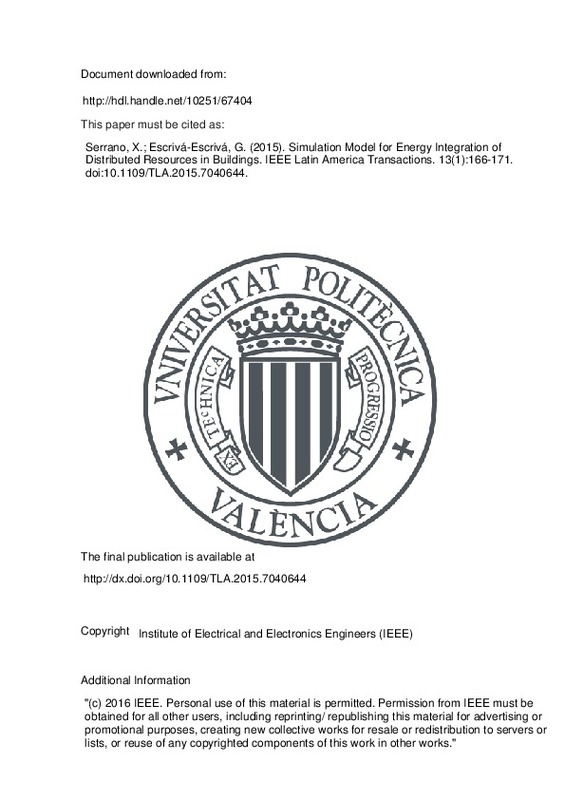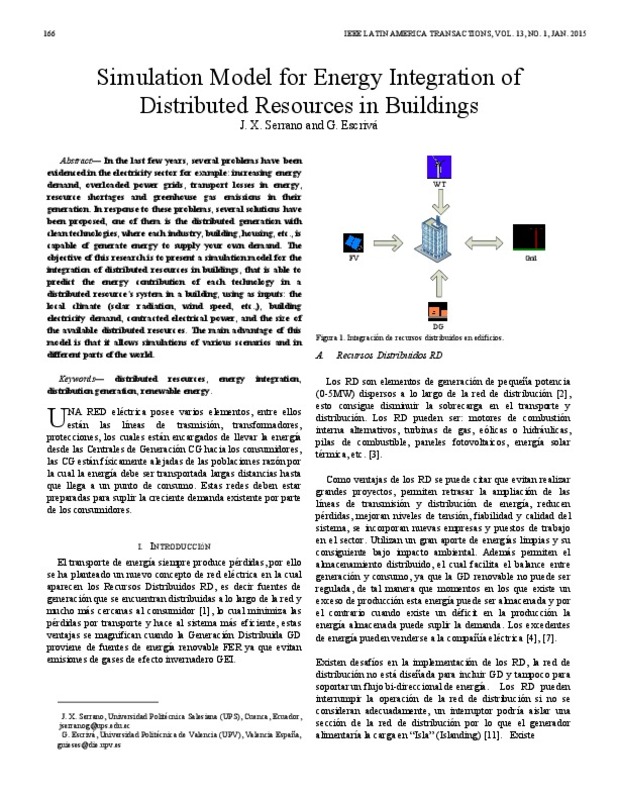JavaScript is disabled for your browser. Some features of this site may not work without it.
Buscar en RiuNet
Listar
Mi cuenta
Estadísticas
Ayuda RiuNet
Admin. UPV
Simulation Model for Energy Integration of Distributed Resources in Buildings
Mostrar el registro sencillo del ítem
Ficheros en el ítem
| dc.contributor.author | Serrano, Xavier
|
es_ES |
| dc.contributor.author | Escrivá-Escrivá, Guillermo
|
es_ES |
| dc.date.accessioned | 2016-07-11T10:16:37Z | |
| dc.date.available | 2016-07-11T10:16:37Z | |
| dc.date.issued | 2015-01 | |
| dc.identifier.issn | 1548-0992 | |
| dc.identifier.uri | http://hdl.handle.net/10251/67404 | |
| dc.description | "(c) 2016 IEEE. Personal use of this material is permitted. Permission from IEEE must be obtained for all other users, including reprinting/ republishing this material for advertising or promotional purposes, creating new collective works for resale or redistribution to servers or lists, or reuse of any copyrighted components of this work in other works." | es_ES |
| dc.description.abstract | In the last few years, several problems have been evidenced in the electricity sector for example: increasing energy demand, overloaded power grids, transport losses in energy, resource shortages and greenhouse gas emissions in their generation. In response to these problems, several solutions have been proposed, one of them is the distributed generation with clean technologies, where each industry, building, housing, etc., is capable of generate energy to supply your own demand. The objective of this research is to present a simulation model for the integration of distributed resources in buildings, that is able to predict the energy contribution of each technology in a distributed resource's system in a building, using as inputs: the local climate (solar radiation, wind speed, etc.,), building electricity demand, contracted electrical power, and the size of the available distributed resources. The main advantage of this model is that it allows simulations of various scenarios and in different parts of the world. | es_ES |
| dc.language | Español | es_ES |
| dc.publisher | Institute of Electrical and Electronics Engineers (IEEE) | es_ES |
| dc.relation.ispartof | IEEE Latin America Transactions | es_ES |
| dc.rights | Reserva de todos los derechos | es_ES |
| dc.subject | distributed resources | es_ES |
| dc.subject | energy integration | es_ES |
| dc.subject | distribution generation | es_ES |
| dc.subject | renewable energy | es_ES |
| dc.subject.classification | INGENIERIA ELECTRICA | es_ES |
| dc.title | Simulation Model for Energy Integration of Distributed Resources in Buildings | es_ES |
| dc.type | Artículo | es_ES |
| dc.identifier.doi | 10.1109/TLA.2015.7040644 | |
| dc.rights.accessRights | Abierto | es_ES |
| dc.contributor.affiliation | Universitat Politècnica de València. Instituto de Ingeniería Energética - Institut d'Enginyeria Energètica | es_ES |
| dc.contributor.affiliation | Universitat Politècnica de València. Departamento de Ingeniería Eléctrica - Departament d'Enginyeria Elèctrica | es_ES |
| dc.description.bibliographicCitation | Serrano, X.; Escrivá-Escrivá, G. (2015). Simulation Model for Energy Integration of Distributed Resources in Buildings. IEEE Latin America Transactions. 13(1):166-171. doi:10.1109/TLA.2015.7040644 | es_ES |
| dc.description.accrualMethod | S | es_ES |
| dc.relation.publisherversion | http://dx.doi.org/10.1109/TLA.2015.7040644 | es_ES |
| dc.description.upvformatpinicio | 166 | es_ES |
| dc.description.upvformatpfin | 171 | es_ES |
| dc.type.version | info:eu-repo/semantics/publishedVersion | es_ES |
| dc.description.volume | 13 | es_ES |
| dc.description.issue | 1 | es_ES |
| dc.relation.senia | 292513 | es_ES |









